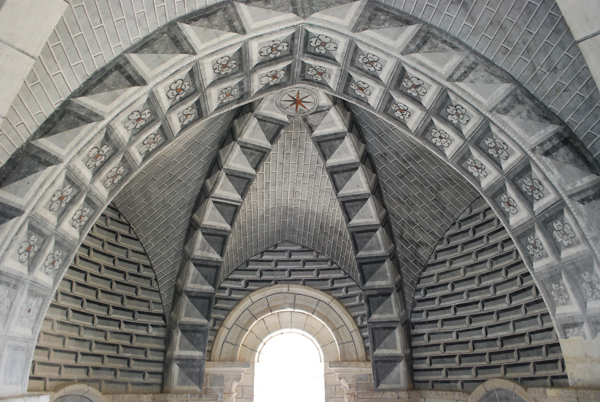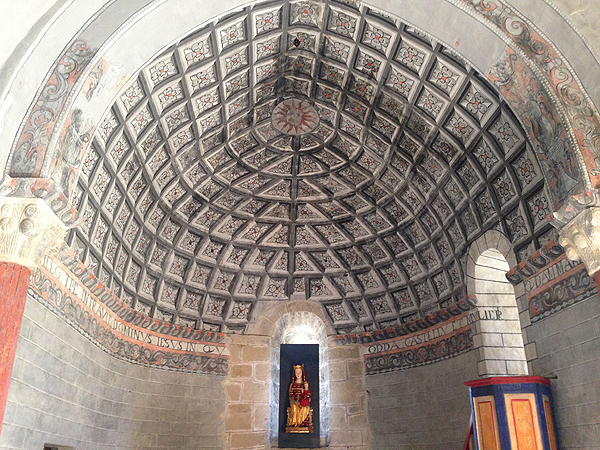24 October 2016
lecture series
THE SKIN OF ARCHITECTURE
The impact of petrophilia on 16th-century mural painting in Navarre
Pedro Luis Echevería Goñi
University of the Basque Country
In the 16th century, the international Gothic mural painting was succeeded by the more modest but essential art of painting and brushing Romanesque and Gothic churches and, logically, those built in that century: by brushing, the artists meant the architectural finishing of Gothic churches by means of rendering, plastering and imitating Renaissance mock-brushwork, while by painting they meant the depiction of figures and stories. In their canonical areas, they skilfully simulated ashlar and profiled brickwork, cushioning and coffered ceilings. It should be noted that Renaissance entablatures, which gave the building a sense of order, were almost always painted. Their purpose was to conceal and ennoble irregular ashlar, masonry or brickwork, to level and unify different surfaces and materials, to establish a spatial modulation and, finally, to evoke a Roman-style art. By "skinning" many churches in the second half of the 20th century of this epidermis, they were deprived of their Renaissance mask, enhancing the Gothic aspect of their masonry. In buildings that have not been chopped, this art remains hidden behind altarpieces, whitewashing, marbling and repainting. In those churches that have not been intervened, a whole pictorial stratigraphy can be traced, renewed according to the dictates of fashion, from the time of their construction until the 1930s.
Petrophilia, a term adopted by D. Wright Carr in 1998, is an aesthetic fashion that overvalues bare stone over other materials and architecture over other arts. It consists of the elimination of lime and sand rendering, plaster and all pictorial layers, leaving the stone exposed with cement mortar grouts. The theoretical foundation of 20th century petrophilia can be found in the middle of the 19th century in the Romantic writer J. Ruskin, who in Seven Lamps of Architecture states that the only colours in architecture should be those of natural stone. The French architect Viollet-Le-Duc, whose criteria inspired the restorations of J. Yárnoz Larrosa and his son J. Mª Yárnoz Orcoyen, postulated "restoration in style", the primacy of Gothic, the elimination of "inferior" elements and painting to emphasise the structure and not disguise it. He also extrapolated the principles of Rationalism, such as the "sincerity of the materials" and deornamentation, to the restoration of historical monuments in some cases.
Although it has notable antecedents from the end of the 19th century, petrophilia in Navarre (1940-1990) began with the foundation of the Institución Príncipe de Viana. At this point, the influence exerted by the Second Vatican Council, in the constitution on the Sacred Liturgy of 1963, should be noted. It was the advocates of petrophilia who used as a shield certain indications such as that the images should be "few in issue", the importance of the altar table and the search for "noble beauty" rather than sumptuousness. Among the numerous churches that were restored in Navarre in this decade, such as the church of Bera (1964-1965), the church of San Miguel de Aoiz stands out, between 1961 and 1964, a work of ashlar that was converted into a "cave" when its cladding was removed, preserving behind the main altarpiece the Renaissance brushwork that ennobled and modulated the masonry.
The 1970s began with the 1972 Rome Restoration Charter, drafted by Cesare Brandi, the first international document to draw attention to the importance of plastering. It specifies that cleaning should never "reach the bare surface of the materials of the work itself" and prohibits the use of abrasive methods. In Navarre, not only were these criteria disregarded, but it was a decade of leadenness in which a multitude of temples were chipped, starting with the church of the monastery of Tulebras, where the stone was removed "in keeping with the austere Cistercian tradition", without taking into account that the vaults had been added in the 16th century and painted in 1563. The 1995 restoration would restore the Renaissance cuttings and fleurons. These "skinning" were carried out by emulation, as happened, for example, in Tierra Estella with those of Larrión, Igúzquiza, Piedramillera and Azuelo. In the latter, restored in 1979, the sacristy was removed, the main altarpiece was dismantled and the successive layers of lime and paint were removed.
The last decade that registers the massive chopping of churches is that of the 80's, inaugurated with the publication of the first Issue of the monumental Catalog of Navarra, dating from 1985 the Spanish Historical Heritage Law. Between 1982 and 1986, of course, the chopping of the walls and vaults was included in the restoration works of the church of San Nicolás in Pamplona. The remains of the grotesques on a red field that decorate the ribs of the vault of the main chapel, which were part of the pictorial decoration made by Miguel de Latorre, a painter from Estella, before 1535, can still be seen. The monumental temple of Villatuerta underwent a restoration in 1986 that consisted of removing the stone, applying sandblasting and cement mortar. Behind two lateral altarpieces, paintings from the 16th century with paired saints were found.

Interior with exposed stone from the parish of Ibiricu de Egüés with the original coffered ceilings and grotesques lost.
Today we are witnessing a restitution and serialisation of painted false rigging (1990-2016), which is justified by the fluctuating concept of the return to its original state, the fragmentary conservation of "minor" and serialised motifs, the high cost of stripping and the dedication of these buildings to worship. In the 1990s, the systematic stripping of churches in Navarre came to an end, and a new type of painting became widespread, with white strokes on a grey background in 16th-century churches such as Santa María de Tafalla, which had been stripped in 1975, Isaba, the Dominicans in Pamplona, the sacristy of the monastery of Irache and Cintruénigo. The findingof the mural paintings in the church of Arellano with different painted rigs and their restoration and restitution by B. Sagasti in 1998, under the direction of J. Sancho, was a turning point and was the work that initiated me in my programs of studyon this pictorial specialization program. Among the principles for the conservation and restoration of mural paintings, ratified by the international committeeof ICOMOS in 2003, the restitution of the same is admitted in specific cases, respecting all the professional protocol. In the restoration of the church of San Saturnino in Artajona, carried out in 2007 by Sagarte, the Gothic and Renaissance quarterings and the crestings of the triumphal arch were serialised and reproduced.
The latest restorations carried out by Sagarte in the crypt of Santa Margarita in the church of El Salvador in Gallipienzo and in the Romanesque church of Vesolla are two examples of actions in which importance is given to the Renaissance faux rigging, although different criteria are applied. In the former, directed by J. L. Franchez in 2014, the exceptional conservation of the grisaille of the 1572 apse justifies a respectful restoration that extends to the maintenance of the extensive chipping of the first section. The church of Vesolla is a good example of the transformation of an early 13th century Romanesque building into a Renaissance building at the end of the second third of the 16th century, with the brushed coffers in the vault evoking the Romanesque ones of the Pantheon or those of the Temple of San Pietro in Montorio. In this work, directed in 2014-2015 by L. Gil Cornet, the remains of a 19th-century painting were removed and the gaps in the coffered ceiling were reintegrated, as well as the ashlar sections of the walls. Finally, the registrationfrieze with the beginning of the parable of Martha and Mary (Luke 10:38) was restored.

Fake fixtures from the crypt of Santa Margarita. Church of San Salvador de Gallipienzo

Coffered ceilings and registrationof the main chapel of the church of Vesolla
I only know of one example of a building completely painted and painted in the 16th century which has not been intervened and which can be seen at samplein Navarre, that of Shrine of Our Lady of Fair Lovede Nuestra Señora de Arquijas in Zúñiga. It is an isolated witness to what was the ornamentation of all our temples with a varied repertoire of false rigging, borders, a serliana, a wide repertoire of grotesque ordinances, plus the Calvary and two hagiographic scenes. proposalTo conclude, I would like to make a final appeal to whoever is responsible for the priority of restoring these paintings or those of one of the few examples of a church completely painted in the 16th century that are still hidden, such as the one in Olejua, with capital letters, not restoring them. In this way, we will be able to question the historical falsehood that the clock in the kingdom of Navarre stopped in medieval art, something that was encouraged by the systematic chopping up of our temples, and demonstrate that it entered the Modern Age by means of these coatings of new Renaissance and later feigned ornaments and ornaments.
